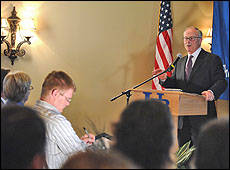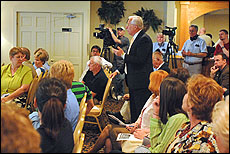Archives
Amherst residents discuss UB's plans for growth
By SUE WUETCHER
Reporter Editor
About 150 Amherst residents ignored the call of a lovely spring evening Tuesday to discuss UB's plans to grow by 40 percent and that growth's impact on their community.

President John B. Simpson tells Amherst residents that as UB thrives, so does their town.
PHOTO: NANCY J. PARISI
The public forum, co-hosted by UB and the Amherst Chamber of Commerce in Marinaccio's Italian Ristorante in Williamsville, featured presentations by UB President John B. Simpson and Robert G. Shibley, professor and director of the Urban Design Project in the School of Architecture and Planning. Shibley is overseeing UB's master-planning process.
Simpson's remarks focused on the central message he's been delivering to myriad community groups, campus groups and state lawmakers: Research universities are good business for the town in which they're located, and as UB grows and prospers, so will its impact on Western New York—and Amherst.
He cited numerous statistics to show UB's economic impact:
UB has a budget of more than $1 billion a year. Its economic impact in Western New York is between $1.4 billion and 1.5 billion. "That is funding we put into the economy in Western New York," more than 4 times what the state gives to the university in tax support, Simpson said.
Faculty members brought in about $290 million during the 2006 fiscal year-mostly from the federal government-to support their research.
Sixty companies have been launched in the region because of the intellectual property generated by UB. These companies have generated revenues of more than $60 million.
UB faculty over the past four years disclosed 340 inventions that resulted in 102 patents and more than 200 licensing agreements.
UB is the "professional backbone" of the community. "Most of the professional folks you encounter will be graduates of UB," Simpson said. For example, nine of 10 dentists practicing in Western New York are graduates of the UB School of Dental Medicine.
UB paychecks go to 5,400 Amherst residents.
"In short, we are very much part and parcel of the community in just about any way in which you can imagine, and we are a very important part of the economic and cultural success and enjoyment we have here in Western New York," he said.
Simpson noted that UB is engaged in the UB 2020 strategic planning process designed to push UB into the top echelon of public research universities. "As the university thrives, as it improves as we anticipate it will, its impact on Western New York and its impact on Amherst will likewise improve. In other words, good universities are good business."
Simpson stressed that UB 2020 is not a plan to grow the university. Increasing the size of the university by 10,000 students and 750 faculty members "is one of tactics to the overall strategy to making the university better," he said.
Along with that comes creation of a comprehensive physical master plan to design "facilities and spaces to support our academic aspirations and our academic directions," Simpson said, noting that this is the first time UB has taken up this issue since the North Campus was located in Amherst some 30 years ago. He said the effort is collaborative, with representatives from the City of Buffalo, Erie County and the NFTA, as well as the Town of Amherst, working with Shibley.
"There is no other entity in Western New York with the kind of potential to be the catalyst for fueling the economy of the future—especially one that is based on ideas and a knowledge economy—as does the University at Buffalo," he said. "No other institution has the ability to be so transformative as does the University at Buffalo."
This is not to say, however, that all of Western New York's economic problems and shortcomings can be dealt with if UB achieves the vision that is laid out in UB 2020, Simpson emphasized. Of all the ideas for economic revival that circulate in Western New York, "this is, in my view, the best. This is the 'big idea.'"
Shibley noted that faculty, staff and students come to a university for the intellectual excitement and the mission of the institution.
"They stay if the communities that host them are great places to live. The two things require each other. We're working to build a physical place on the campus and in relationship to the campus that's truly great enough to attract the kind of numbers and the kind of skill that we know we need to make the contributions to our mission and to make the contributions to the regions where we live."
The master planning effort is about the academic mission, about handling the 40 percent growth and about making a place for interdisciplinary work—a key element of the UB 2020 strategic strengths, Shibley said.
Moreover, "Our campus ought to be a place we can come to love, that we really like it on the campus," he said, "and have a clear and unadulterated connection to the community where we share in the community resources and the community shares in our resources."
UB would need to plan even if it did not have a plan to grow, he said. A five-year, $400 million capital program already is under way, he noted. "Nobody does a serious investment of $400 million without thinking about how to do it. That's planning. That's what we're trying to do here."
With $400 million already allocated for capital work, "action can't wait for this (master plan). We need to get moving," Shibley said.
Work in progress mentioned by Shibley includes a facelift for Allen Hall, renovation of Acheson Hall for the School of Pharmacy and Pharmaceutical Sciences and a new South Campus home for the UB Child Care Center, as well as heating work on the South Campus and critical maintenance to Founders Plaza on the North Campus.
For UB to be a model 21st century university, "we have to be a better place—regionally and physically on the campus," Shibley said. "We have to accommodate our growth and make a place for interdisciplinary collaboration. To do that, we have to make a great campus. Great universities have great campuses."
Following Shibley's presentation, he and Marsha S. Henderson, vice president for external affairs, fielded questions from residents for nearly an hour. Many concerned student housing and UB's decision to file a lawsuit after the Amherst Town Board ignored its own master plan—and the advice of the town attorney—and voted to rezone a 22-acre parcel of land on Rensch Road off of Sweet Home Road to permit construction of a 225-unit apartment complex for students. The board subsequently rescinded the vote.

Eric Gillert, director of planning for the Town of Amherst, participates in the forum discussion.
PHOTO: NANCY J. PARISI
One resident pointed to the concentration of student housing being built in the Willow Ridge area along the western boundary of the North Campus. Where, he asked, will the 10,000 students that UB plans to enroll over the next 15 years live?
Shibley noted that the university intends to build more housing on campus and plans to start with 1,200 new beds. "We are holding to the notion that about 30 percent (of the student body) is the number in terms of what we accommodate on our campus. We believe we can integrate the remaining 70 percent into a variety of marketplaces across our region so that students are integral with, rather than in enclaves separate from the communities that host us." "We will not grow without addressing housing," he stressed.
Shibley said that the large numbers of students living in the University Heights neighborhood surrounding the South Campus "is not good for the City of Buffalo and it's not good for the university. We are quite distressed about that and certainly don't want to do that again around the North Campus."
Henderson, who moderated the Q&A session, added: "We do think that the best way in which students housing should take place is to be integrated into communities, not necessarily concentrated in high density."
A Rensch Road resident who sold his home to the developer of the proposed student housing project told Henderson he and other residents now "find ourselves in a tough spot. "We thought we were contributing to the growth of UB (by selling their homes for the project). Now we find ourselves with two homes. What does UB have in store for us?"
Henderson noted that the zoning process is under the auspices of the town board and its appropriate boards. The university expressed concern during the zoning process about the density of the student population in that area and the breakup of the property—spot zoning—along Rensch Road.
"The lawsuit is related to the procedural questions and considerations that took place in making those zoning decisions (to rezone the property from research and development to multifamily to accommodate the housing project). UB is in the midst of its planning process," she said. "We're not as far along as the town is in its comprehensive plan. I wish we were so we could sit here today and tell you something more definitive about that property or all of our properties," she said. "We do feel that it would be inappropriate for the town to be making decisions in the manner in which it made them without more considered thought with the university as our plan develops more fully."
In response to a comment from a resident that UB, via its lawsuit, was "making decisions for the Town of Amherst," town council member William Kindel noted that the town board had voted to rezone the property, despite being told by the town attorney that it was illegal to do so because it would violate the master plan. The subsequent vote by the board to rescind the zoning change "was not a question of land use; it was a question of following the law."
Kindel said he expects the developer to resubmit its request and that the board could amend the master plan to allow for the development.
